Block access to Registry Editor on Windows 10/8/7
The registry is a hierarchical database that stores the values of parameters in windows and applications and services running on the Windows operating system. Suppose for some reason, for example, if you don't want others to access Reigstry Editor to edit some settings on Windows, you can disable Registry Editor. In the article below, Network Administrator will show you how to disable Registry Editor on Windows 10/8/7 .

1. For users of the Home version
If you use Windows 7, 8 or 10 Home versions, to disable Registry access you will have to edit the Windows Registry. In addition, if you use Windows Pro or Enterprise version, you will have to use Local Group Policy Editor.
Warning:
Registry Editor is quite powerful tool, and affects the system. So before proceeding to the next step, you should make a backup of the Registry in case something goes wrong.
Before proceeding to edit the Registry you must perform the following two steps:
- If the user account you want to block access to the Registry is a Standard account. You will have to temporarily change that account as an Admin account. This allows you to make the changes you need. And after you're done, you should change your account to its original state.
- You will have to log in to the user account (user account) that you want to make changes to the permissions and edit the Registry after logging in to your account.
- If there are multiple user accounts (user accounts) and you want to change permissions for all these accounts, you will have to follow the same steps for each account.
After you have logged in the user account you want to apply the changes to, change the steps below:
First open the Registry Editor window by clicking Start, then enter regedit in the Search box and then press Enter to open the Registry Editor window. If the UAC window appears, click Yes to allow the permission to change your computer.
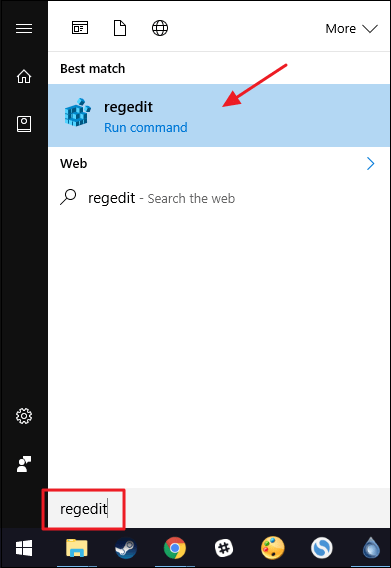
On the Registry Editor window, navigate to the key:
HKEY_CURRENT_USERSOFTWAREMicrosoftWindowsCurrentVersionPoliciesSystem
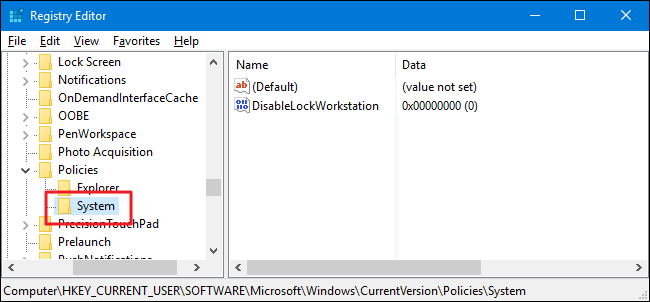
The next step is to create a new value in the System key. Right-click the System key, then select New => DWORD (320bit) value . Name this new value as "DisableRegistryTools" .
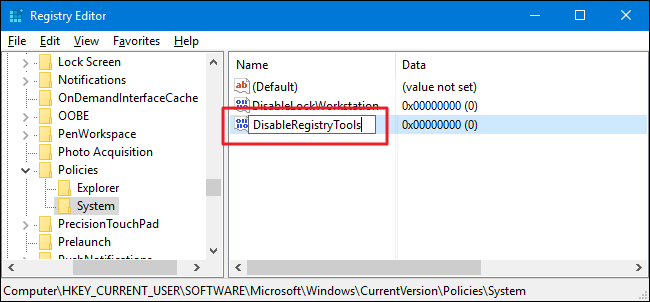
Next double click on the DisableRegistryTools value to open the Properties window. Here you change the value in the Value Data frame from 0 to 1 then click OK.
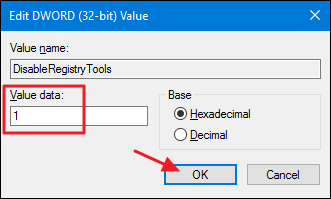
You can now close the Registry Editor window. The changes will be applied immediately and you can check it out by trying to open Registry Editor again. At this time on the screen you will receive an error message.
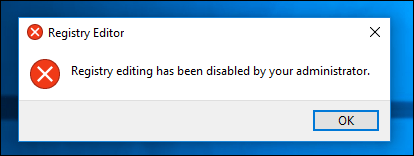
In case if you want to return to the original settings, you will have to log back into the user account (user account), change the account to the Admin account (if not yet an Admin account), then open the door. Command Prompt window under Admin. On the Command Prompt window, enter the following command into:
reg add "HKCUSoftwareMicrosoftWindowsCurrentVersionPoliciesSystem" / t Reg_dword / v DisableRegistryTools / f / d 0
The above command to change the DisableRegistryTools value from 1 to 0.
2. Use Registry editing available
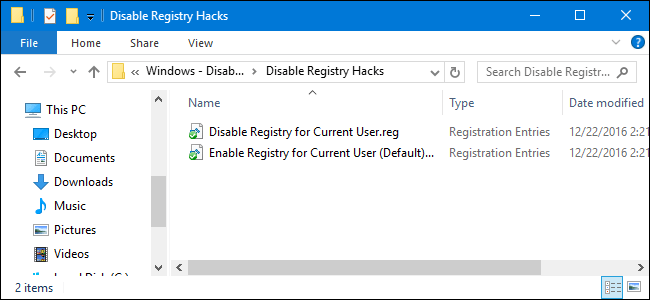
If you do not want to manually edit the Registry, you can use the Registry available to disable Registry access on the system.
Download Registry Hacks to your computer and install it here.
The next step is to extract the Zip Registry Hacks file that you downloaded. You should now see two files that are Disable Registry for Current User and Enable Registry for Current User (Default). Double-click the Disable Registry for Current User file to disable the Registry access and double-click the file Enable Registry for Current User (Default) to enable the permissions to access the Registry.
To use the Registry editing available, follow the steps below:
1. Change the user account (user account) you want to disable Registry access to the Admin account (if the account is not an Admin account).
2. Log in to the user account (user account) you want to apply the change to.
3. Double-click the edit file and follow the on-screen instructions.
4. Proceed to logout then log in to your Admin account again.
5. Change the user account (user account) that you applied to the Standard account change that you set up the previous edit.
3. For Pro and Enterprise users
If you use Windows Pro or Windows Enterprise, the easiest way to disable Registry access is to use Local Group Policy Editor.
First open the Group Policy Editor window by pressing the Windows + R key combination to open the Run dialog box, then enter gpedit.msc in the Run window and select OK .
Alternatively, you can refer to some of the ways to open the Local Group Policy Editor window here.
On the Group Policy window, navigate to the key:
User Configuration => Administrative Templates => System
In the right pane, find and double-click the item called Prevent access to the registry editing tools to open the Properties window.
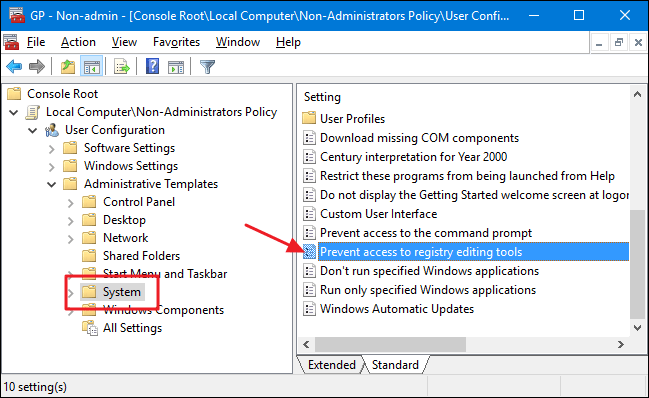
On the Properties window, click on the Enabled option and make sure the Disable regedit from running option is set to Yes . If you do not set the Disable regedit option from running silently to Yes, users will not be able to make changes to the Registry.
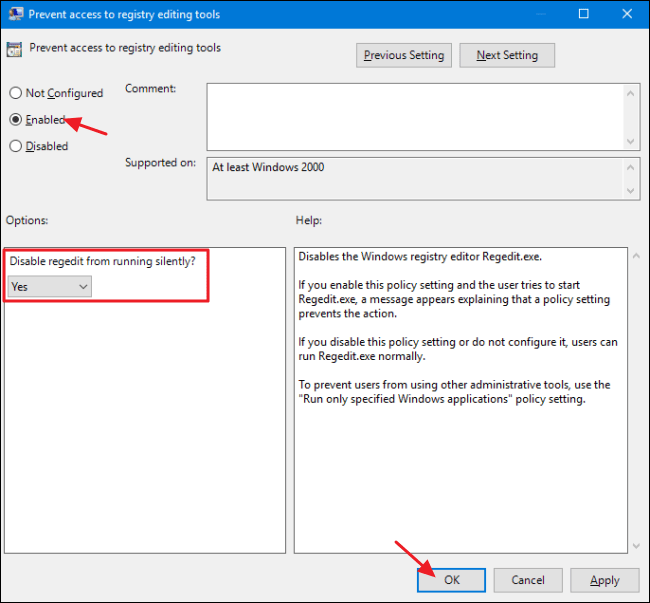
Once done, click OK.
Finally close the Local Group Policy Editor window again. Changes will apply immediately. To check you only need to open the Registry Editor and on the screen you will receive an error message.
If you want to change the settings back to the default state, just follow the same steps and change the settings of the Prevent access to registry editing tools option to Not Configured.
Refer to some of the following articles:
- 50 Registry tricks to help you become a true Windows 7 / Vista "hacker" (Part 3)
- 50 Registry tricks to help you become a true Windows 7 / Vista "hacker" (Part 2)
- 50 Registry tricks to help you become a true Windows 7 / Vista "hacker" (Part 1)
Good luck!
You should read it
- Microsoft adds the address bar to the Registry Editor
- How to Use Regedit
- Use the .reg file to configure the Registry in WinXP
- How to Get Into a Computer Registry
- 50 Registry tricks to help you become a true Windows 7 / Vista 'hacker' (Part 3)
- How to Make and Restore a Backup of the Windows Registry
- Learn about the Windows Registry - Part I
- How to Edit the Windows Registry
May be interested
- How to uninstall Windows Insider Program Windows 10
 windows 10 windows insider program is a program registered with those who want to experience before the preview will be upgraded to the full version before it is released.
windows 10 windows insider program is a program registered with those who want to experience before the preview will be upgraded to the full version before it is released. - How to change, prolong the delay of updating on Windows 10?
 on windows 10 profesional, enterprise and education versions are allowed to postpone updates (update), so users will not have to download the update for a while. you can use local group policy to set a delay time other than the default time.
on windows 10 profesional, enterprise and education versions are allowed to postpone updates (update), so users will not have to download the update for a while. you can use local group policy to set a delay time other than the default time. - How to view recently deleted files on Windows 10?
 usually when you delete any file on a windows 10 computer by right-clicking on the file and selecting delete or selecting the file then pressing the delete key, then the file will be moved to recycle bin. or another way to permanently delete files is to press shift + delete, and windows will move these files from recycle bin.
usually when you delete any file on a windows 10 computer by right-clicking on the file and selecting delete or selecting the file then pressing the delete key, then the file will be moved to recycle bin. or another way to permanently delete files is to press shift + delete, and windows will move these files from recycle bin. - Instructions for activating Keyboard Backlight on Windows 10
 some computer brands integrate led lighting into keys and spacing between keys. for users, sometimes this feature is not necessary, and that's why the keyboard backlight feature is disabled. but in some cases you will need to rely on the support of this feature.
some computer brands integrate led lighting into keys and spacing between keys. for users, sometimes this feature is not necessary, and that's why the keyboard backlight feature is disabled. but in some cases you will need to rely on the support of this feature. - Prevent Microsoft from collecting system information on Windows 10
 customer experience improvement program (ceip) is a feature enabled by default on windows 10. this feature will secretly collect information on the system to report to microsoft. the information that customer experience improvement program (ceip) collects includes hardware configuration and how you use the operating system and other programs and software.
customer experience improvement program (ceip) is a feature enabled by default on windows 10. this feature will secretly collect information on the system to report to microsoft. the information that customer experience improvement program (ceip) collects includes hardware configuration and how you use the operating system and other programs and software. - How to install Windows 10 Themes from Windows Store?
 starting with windows 10 build 14951, microsoft provides users with a new solution to download and install the theme for windows 10 computers. from now on, users can download the theme for windows 10 through the windows store integrated on. windows personalization gallery page.
starting with windows 10 build 14951, microsoft provides users with a new solution to download and install the theme for windows 10 computers. from now on, users can download the theme for windows 10 through the windows store integrated on. windows personalization gallery page.






 How to Use Regedit
How to Use Regedit How to Enable Regedit
How to Enable Regedit How to Use Regedit
How to Use Regedit How to open the Registry Editor on Windows
How to open the Registry Editor on Windows Unlock hidden features on Windows 10 with some Registry tricks
Unlock hidden features on Windows 10 with some Registry tricks